Images
All photos taken on July 19, 2002Select an image to view a larger version
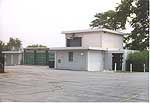

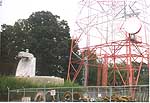
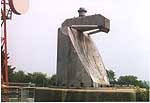
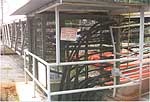
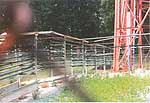
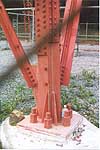
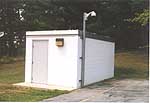
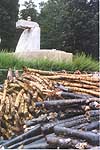
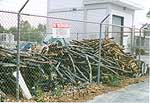
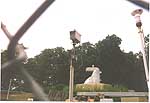
[MD-1] is a fictitious name. AT&T Corporate Security has requested that the names and exact locations of active AT&T network facilities not be published. Accordingly, such facilities are identified on this web site by fictitious names, shown in [brackets].
[MD-1] is an example - among the oldest - of the highly specialized facilities constructed by AT&T to provide national-security communications during the Cold War. Its principal structures are:
Two underground buildings, hardened to protect people and equipment against the effects of a nuclear blast. The buildings are approximately equal in size, each containing two tall floors plus a mezzanine level on the upper floor.
A self-supporting steel tower, 377 feet tall, holding the following microwave antennas: three pairs of Western Electric KS-15676 horn reflectors, one pair of conical horn reflectors, and a single parabolic. The microwave radio equipment is housed in the underground space.
A concrete-backed, blast-hardened microwave parabolic antenna, mounted on a short foundation near the tower. This antenna was not part of the original facility; it was likely added around 1968.
Two surface buildings providing access and support to the underground space. The newer of these buildings houses a large elevator. The older structure appears typical of those found at other AT&T underground stations, and may have been expanded one or more times.
AT&T purchased the property on July 7, 1960. Construction of the first underground structure began that year, with occupancy starting in 1961. This is earlier than most, if not all, of the other underground AT&T stations.
[MD-1] was a manned station, and during at least some of the Cold War years had sleeping accommodations, a kitchen, and food, water, and medical supplies for the Bell System employees who would be on duty to maintain vital military and civil-defense communications links in the event of a nuclear attack. Some or all of the employees were required to have federal Top Secret security clearances. At one time, the station was home to approximately 125 technicians, ten supervisors, and two mid-level managers.
[MD-1] was constructed as a switching station, named "Frederick", in the Army's Switched Circuit Automatic Network (SCAN). SCAN, activated in December 1961, was the predecessor to the more extensive Automatic Voice Network (AUTOVON) system. [MD-1] was known within AT&T as "Frederick No. 2" in its early years.
In 1964, construction began on [MD-1]'s second underground building. From then on, the two structures were known as "the old building" and "the new building". The new building may have been constructed to house switching equipment for AUTOVON.
[MD-1] was a main station on the hardened coaxial-cable route between Airmont, New York and Mojave, California. Later, it was also connected by coaxial cable to an underground station in northen Virginia (opened in 1969) on the Boston-Miami coaxial-cable route. The next main stations on the Airmont-Mojave cable were Pottstown, PA to the north and Williamstown, KY to the west.
Repeaters, housed in concrete vaults under small brick or concrete-block huts, were spaced at aproximately equal intervals along the entire length of the route. The route's original coaxial-cable technology, named L3, required repeaters four miles apart. The repeaters received the electrical power through the cable itself, and power-feed stations were located at intervals between the main stations to inject high-voltage power into the cable. Between [MD-1] and Williamstown, these facilities were located near Mount Storm and Pennsboro, WV. The power-feed stations were underground and hardened, but were smaller than the main stations and were not manned full-time.
As the cable was upgraded in capacity, additional repeaters were inserted between the original locations. The new repeaters were housed entirely underground and were reached through manholes. Upgrading the cable from L3 to L4 required, reducing the spacing from four miles to two, doubling the number of repeaters.
[MD-1] housed switching equipment for several communications networks which AT&T operated for the Department of Defense. It was a major switching center for AUTOVON, as well as for leased lines serving defense-related facilities. Several circuits for the Automatic Secure Voice Communications network (AUTOSEVOCOM) and the Automatic Digital Network (AUTODIN) passed through the facility, with an interface arrangement allowing a few AUTODIN lines to connect with AUTOVON lines.
A coaxial-cable spur line linked the station to the Department of Defense's Alternate Joint Communications Center (AJCC), also known as Site R, a hardened facility inside Raven Rock Mountain near Blue Ridge Summit, PA. Another cable, using copper wire pairs rather than coaxial conductors, served the federal Office of Emergency Preparedness (OEP) underground facility on Riggs Road in Montgomery County, MD between Olney and Laytonsville. The OEP installation was the Alternate National Warning Center, one of two centers (the other is at the North American Air Defense Command's Cheyenne Mountain underground complex) which would issue a warning of a nuclear attack on the United States. Because of that important mission, it is likely that the facility always had a cable connection to [MD-1].
[MD-1]'s 4-wire No. 5 crossbar switching machine also served the Federal Telephone System (FTS), a long-distance network for the civilian agencies of the federal government, which went into service in February 1963.
The lower floor of the old building contained contained the multiplex equipment, microwave radios, mobile terminals, L3 coaxial-cable equipment and the wiring frame. The upper floor contained the crossbar switch, testboard, and power room. An AUTOVON dial service assistance switchboard was located on the mezzanine.
Emergency electrical power was supplied by five large Diesel engines - two on one level and three on the other.
The mezzanine level of the new building served primarily as an emergency relocation site for executives of AT&T's Eastern Region, and space was also provided for C&P Telephone officials.
[MD-1] had five microwave paths licensed by the FCC, as shown on the map below. It is very likely that one of [MD-1]'s functions was to provide an interface between the Washington area's microwave network and the coaxial-cable routes. Some or all of [MD-1]'s microwave paths undoubtedly carried national-security communications.
[MD-1] remains an active, manned AT&T facility, housing fiber-optic terminal equipment and a Lucent Technologies 4ESS (electronic switching system) for AT&T's long-distance service. Typically, the 4ESS handles approximately 400,000 calls per hour during weekdays. Four of [MD-1]'s microwave paths are still licensed; the license for the path to Clarksville has been canceled. The original TD-2 microwave radios, operating in the 4 GHz band, have been replaced by DR-6 digital radios in the 6 GHz band.
In early 1998, the station was undergoing remodeling. The work included construction of a new, large freight elevator enclosed in a separate building.
Fiber-optic cables have replaced the coaxial cables on [MD-1]'s north, south, and west-bound cable routes, and on the link to the AJCC. The cable to the underground OEP (now FEMA) facility on Riggs Road is no longer in service.
The black lines represent licensed paths as of October 2001; the red line shows the destination of a canceled path.
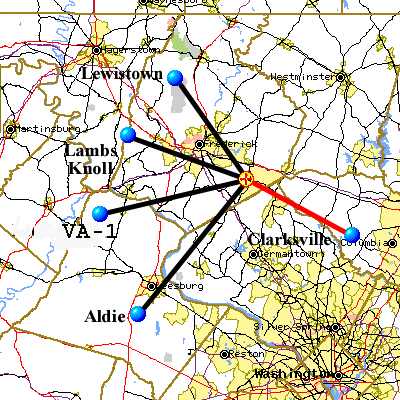
 |
 |
 |
 |
 |
 |
 |
 |
 |
 |
 |
Updated on July 15, 2004 at 23:55 by Albert LaFrance